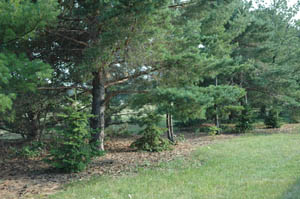Creative Disease Management | |
|---|---|
| June 19, 2007 | |
|
One of the most common disease problems in Illinois landscapes is Diplodia blight. The name started out as Diplodia blight, was changed to Sphaeropsis blight for about 20 years, and is now Diplodia blight again. The disease is easy to spot in the landscape. It causes needles at the tips of branches to turn brown and die. The canker phase of the disease can cause some unsightly branch oozing and may kill the infected branch. There are articles about this disease every year. For more information, consult the Report on Plant Disease, no. 625, “Sphaeropsis Blight or Diplodia Tipblight of Pines,” available on the Web at http://www.ag.uiuc.edu/~vista/horticul.htm. Management of this disease is difficult. Removing infected branch tips helps. Because the fungus may be found on the cones, raking and removing them from the site helps reduce fungal inoculum. It has been shown that drought-stressed pines are more susceptible to infection, so another cultural control is to provide water to your pines in periods of extended drought. For many of us, that means watering now. Fungicides are also an option when used as preventives to protect new growth. Consult the Illinois Commercial Landscape & Turfgrass Pest Management Handbook or the Home, Yard, and Garden Pest Guide for options; the books are sold online at https://PubsPlus.uiuc.edu/. Chemical control requires three sprays per year and can become quite costly, especially on large trees. In addition, trees may be infected before they show symptoms. Many landscapers have begun to work with this disease problem rather than try to eradicate it. We all know there is no ideal tree. Why not keep your pines, manage the disease as well as you can, and still plan for the future?  The image shows some young firs planted under a line of declining Scotch pines with Diplodia blight. The owner removes dead wood as it appears and keeps trees watered in drought. As the Scotch pines become thinned out, the younger trees get more sun and room to grow. Eventually the firs replace the Scotch pines, but the row of trees remains. Maybe some day the firs will also have to be replaced. Not shown in the image is the fact that other species were planted as well. It is best not to put all your eggs in one basket. Plant a diversity of species. If a disease or insect problem develops, it is less likely that all trees will be affected. The image shows some young firs planted under a line of declining Scotch pines with Diplodia blight. The owner removes dead wood as it appears and keeps trees watered in drought. As the Scotch pines become thinned out, the younger trees get more sun and room to grow. Eventually the firs replace the Scotch pines, but the row of trees remains. Maybe some day the firs will also have to be replaced. Not shown in the image is the fact that other species were planted as well. It is best not to put all your eggs in one basket. Plant a diversity of species. If a disease or insect problem develops, it is less likely that all trees will be affected.The concept of planting replacement trees near declining trees can be used with other diseases as well. First, determine whether your plant has a disease that is a threat to nearby trees. For instance, a tree with Dutch elm disease needs to be removed to protect other nearby elms. If the disease is not a threat to other trees, consider the management options. Not all diseased trees have to be removed; and chemicals are not always the answer. Devise a plant that is best for you, your plants, and your neighbors’ plants. Be creative. |